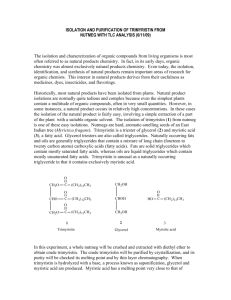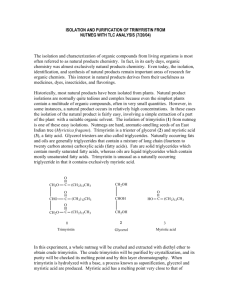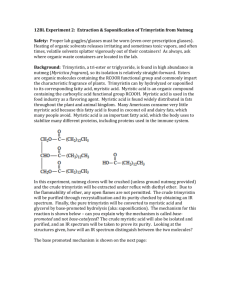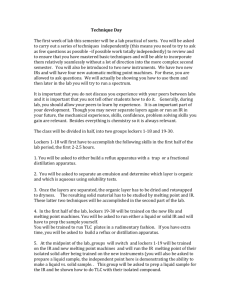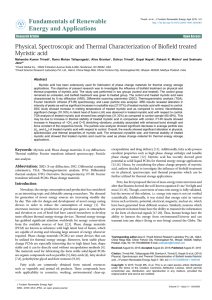Trimyristin Exp
advertisement
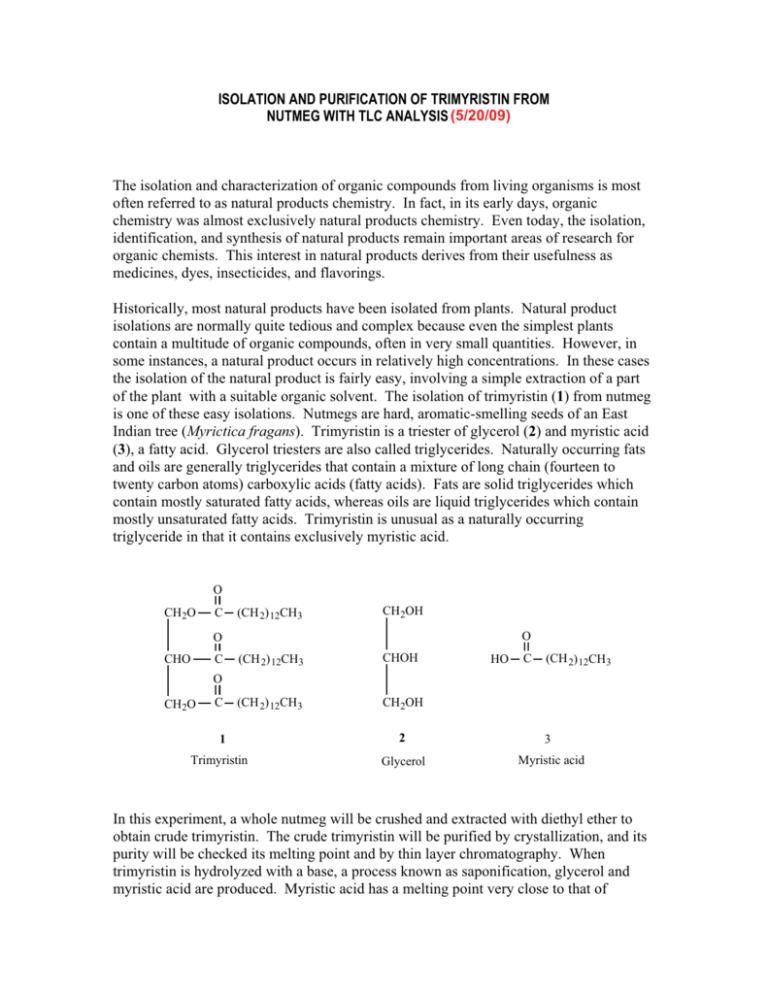
ISOLATION AND PURIFICATION OF TRIMYRISTIN FROM NUTMEG WITH TLC ANALYSIS (5/20/09) (7/20/04) The isolation and characterization of organic compounds from living organisms is most often referred to as natural products chemistry. In fact, in its early days, organic chemistry was almost exclusively natural products chemistry. Even today, the isolation, identification, and synthesis of natural products remain important areas of research for organic chemists. This interest in natural products derives from their usefulness as medicines, dyes, insecticides, and flavorings. Historically, most natural products have been isolated from plants. Natural product isolations are normally quite tedious and complex because even the simplest plants contain a multitude of organic compounds, often in very small quantities. However, in some instances, a natural product occurs in relatively high concentrations. In these cases the isolation of the natural product is fairly easy, involving a simple extraction of a part of the plant with a suitable organic solvent. The isolation of trimyristin (1) from nutmeg is one of these easy isolations. Nutmegs are hard, aromatic-smelling seeds of an East Indian tree (Myrictica fragans). Trimyristin is a triester of glycerol (2) and myristic acid (3), a fatty acid. Glycerol triesters are also called triglycerides. Naturally occurring fats and oils are generally triglycerides that contain a mixture of long chain (fourteen to twenty carbon atoms) carboxylic acids (fatty acids). Fats are solid triglycerides which contain mostly saturated fatty acids, whereas oils are liquid triglycerides which contain mostly unsaturated fatty acids. Trimyristin is unusual as a naturally occurring triglyceride in that it contains exclusively myristic acid. O CH2O C (CH 2) 12CH3 CH2OH O O CHO C (CH 2) 12CH3 CHOH (CH 2) 12CH3 CH2OH HO C (CH 2) 12CH3 O CH2O C 1 2 3 Trimyristin Glycerol Myristic acid In this experiment, a whole nutmeg will be crushed and extracted with diethyl ether to obtain crude trimyristin. The crude trimyristin will be purified by crystallization, and its purity will be checked its melting point and by thin layer chromatography. When trimyristin is hydrolyzed with a base, a process known as saponification, glycerol and myristic acid are produced. Myristic acid has a melting point very close to that of trimyristin so that a melting point alone is not sufficient for distinguishing trimyristin from myristic acid. However trimyristin and myristic acid may be readily distinguished by thin layer chromatography. Experimental Procedure First Lab Crush and grind a whole nutmeg with a mortar and pestle for approximately 5 min. (no need to pulverize). Weigh the ground nutmeg and transfer it to a 50 mL round-bottomed flask. Add 15 mL of diethyl ether, attach a water-cooled condenser to the flask, and heat the mixture under a gentle reflux for approximately 15 min. using a thermowell. Allow the mixture to cool to room temperature. Without disturbing the settled solids, decant and gravity-filter the ether solution into a 125 mL Erlenmeyer flask. Add another 10 mL of diethyl ether to the solid residue, swirl for a few minutes, and transfer the contents to the filter. Prepare a TLC plate and apply a small amount of the filtrate (crude product). (Wait until the following week to develop in a chamber.) Finally, quantitatively transfer the filtrate to a round bottom flask and remove the solvent using a rotary evaporator. Second Lab Add sufficient reagent grade acetone to dissolve the remaining crude solid product (approximately 3-5 mL of acetone, the amount will vary depending upon the weight of nutmeg extracted). Allow to cool to room temperature. Collect the crystalline trimyristin by vacuum filtration and allow it to air-dry. Weigh the product and calculate the percent of trimyristin in the nutmeg. Place a small amount (the tip of a spatula) of the purified trimyristin in a test tube, then add a drop or two of chloroform. Do likewise with the crude product. Next, obtain a small amount of prepared myristic acid (saponified trimyristin) and dissolve in chloroform (same amounts/procedure as used for trimyristin & crude product). Spot the TLC plate with each of the chloroform solutions and develop the plate using chloroform as the solvent. Place the plate under UV light and observe. Next, develop the plate in an iodine chamber. Note that myristic acid adsorbs less iodine than the surrounding silica gel and appears as a white spot on a yellow-brown background. Place some dry trimyristin, just enough to see, in a melting point capillary. Do likewise with a small amount of prepared myristic acid and determine the melting point of the two compounds. The melting point should be near 56oC. Remember that melting point determinations are most accurate when the temperature rise near the melting point (within 10qC) is approximately 1-2oC/min. Prepare the TLC plate in a manner consistant with those prepared in the lab’s introductory experiment, “TLC of Analgesics”. Do not discard TLC plates. Attach to the postlab exercise form. ¥ Perform purification, TLC and melting point analysis during 2nd week of this experiment. Always use a flask (not a beaker) to contain volatile reagents. A flask must always be used for crystallization/recrystallization procedures! WASTE DISPOSAL NOTES: Nutmeg, Trimyristin, and Myristic Acid should all be disposed of in the Non-hazardous Solid Waste Container (located in the Waste Hood) REFLUX APPARATUS NOTE: Use a hose clamp to anchor hoses to the condenser inlet and outlets! Name:__________________________________ Section:_______ Date:_______ POSTLAB EXERCISE FOR: Extraction of Trimyristin from Nutmeg with TLC Analysis (7/20/2004) >> Due no later than the 2nd Friday following the scheduled experiment; no exceptions will be made! Please answer questions on this form. (30pts TOTAL) << A. PRODUCT INFORMATION (15pts) TRIMYRISTIN (10pts) %Recovery (4pts): (4pts) Melting Point (4pts): (2pts) Appearance (describe) (4pts): (4pts) MYRISTIC ACID (2pts) X (0pts – n/a) (2pts) X (0pts – n/a) (3pts) Indicate the appearance of your TLC plate (below) and attach originals to this form. Be sure to identify as many of the components as possible! B. SUMMARY QUESTIONS (15pts) 1) (4pts) Is melting point determination or thin-layer chromatography analysis a better method to determine the purity of trimyristin? Explain. 2) (4pts) Was the melting point or thin-layer chromatography a better method for distinguishing between the compounds trimyristin and myristic acid? Explain. 3) (4pts) Why was the whole nutmeg crushed and ground before it was extracted with diethyl ether? 4) (3pts) Would water be a suitable solvent for extracting trimyristin from nutmeg?
